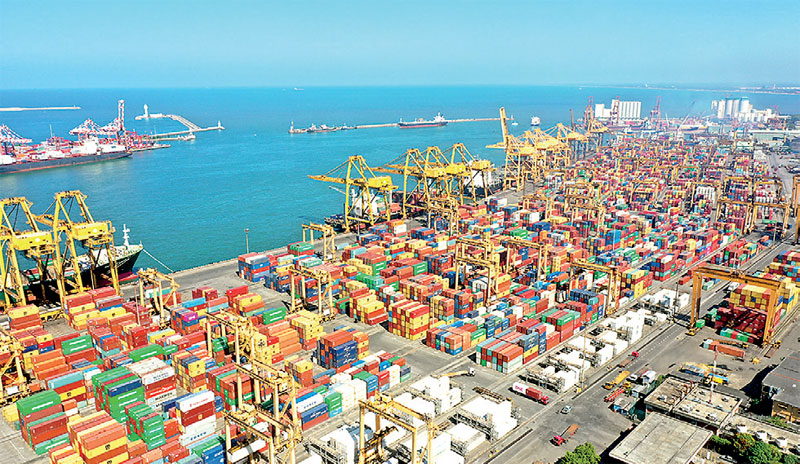
- Despite restrictions and forex shortage, 2021 imports figure soars by 28.5% or $ 4.6 b to $ 20.6 b; highest in three years
- December inflows highest ever at $ 2.2 b
- Fuel imports in 2021 up by $ 1.2 b; textiles and textile articles by $ 732 m machinery equipment by $ 633 m, base metals by $ 406 m, medical and pharmaceuticals by $ 287 m, chemical products by $ 243 m and plastics and articles thereof by $ 225.6 m
- Sharp increase in rubber and rubber articles, telecommunication devices, home appliances, food and beverages, non-food consumables, clothing and accessories imports
- Fertiliser imports down 39% to $ 158 million though December sees pick up
- Import of personal vehicles plunges by 96% to $ 13 m
 Sri Lanka’s love for imports remains irresistible as confirmed by the Central Bank’s latest data with value in 2021 rising to highest in three years and December figure reaching an all-time record.
Sri Lanka’s love for imports remains irresistible as confirmed by the Central Bank’s latest data with value in 2021 rising to highest in three years and December figure reaching an all-time record.
Imports in 2021 rose by 28.5% or $ 4.6 billion to $ 20.6 billion from $ 16 billion in 2020 with December notching up a record high value of $ 2.2 billion, up sharply by 47%.
The all-time highest imports figure was $ 22.2 billion in 2018 whilst in 2017 it was $ 21 billion. The 2021 figure also ended the declining trend of imports since 2018.
The rebound in imports is despite various measures by the Government to discourage non-essential items as well as a foreign exchange shortage dumbfounding policymakers.
Analysts opined high imports especially in the early part of last year were due to the trade and industry ordering extra stocks anticipating a forex crisis in the second half. The country’s current predicament proves that mindset.
CBSL said 2021 saw fuel imports soar by a record $ 1.2 billion and textiles and textile articles by $ 732 million, machinery equipment by $ 633 million, base metals by $ 406 million, medical and pharmaceuticals by $ 287 million, chemical products by $ 243 million and plastics and articles thereof by $ 225.6 million. Fertiliser imports were down by 39% to $ 158 million on account of the Government’s ban on chemical variants though the relaxation saw shipments in December up 21% to $ 37 million.
Import of personal vehicles was down by 96% to $ 13 million.
In December, increases in import expenditure were observed across all main categories, while importation of intermediate goods contributed the most.
Expenditure on the importation of consumer goods in December 2021 increased by 27.9% to $ 419 million mainly driven by the increases in expenditure on non-food consumer goods. Expenditure on non-food consumer goods increased by 46.2% to $248.1 million, contributed mainly by medical and pharmaceuticals (mainly vaccines).
Importation of clothing and accessories, cosmetics, and toiletries and rubber products (mainly tyres) also recorded increases in expenditure. Expenditure on food and beverages imports increased by 8.3% (y-o-y), mainly owing to the importation of cereals and milling industry products (primarily rice), fruits (mainly dried fruits and apples) and sugar.
Decreases in import expenditure were observed in dairy products (mainly milk powder), oils and fats (mainly coconut oil), vegetables (mainly big onions), telecommunication devices (mainly mobile phones), spices (mainly chillies) and seafood (mainly sprats).
The cumulative expenditure on the importation of consumer goods during 2021 increased by 13.1% to $ 3.8 billion, compared to 2020, mainly due the increases in medical and pharmaceuticals, telecommunication devices, home appliances, oils and fats, and cereals and milling industry products amidst extremely low imports of personal use motor vehicles.
Expenditure on the importation of intermediate goods increased by 58.2% (y-o-y) to $ 1.38 billion in December 2021, driven mainly by fuel, base metals, textiles and textile articles, plastics and articles thereof, rubber and articles and fertiliser.
Expenditure on fuel increased by 88.2% in December 2021, due to the increases of import volume and prices of refined petroleum by 43.3% and 45.6% (y-o-y), respectively. Expenditure on crude oil and coal also increased, driven by import prices. Average import price of crude oil recorded $85.38 per barrel in December 2021 compared to $ 51.89 per barrel recorded in December 2020.
Expenditure on base metals increased by 456.9% mainly due to the increase in importation of iron and non-alloy steel. Import expenditure on wheat declined during December 2021.
The cumulative expenditure on the importation of intermediate goods increased by 35.6% to $ 12.3 billion in 2021, compared to the year 2020, mainly driven by fuel, textiles and textile articles, base metals, chemical products, plastics and articles, and rubber and articles.
The 36.1% increase in expenditure on the importation of investment goods in December 2021, compared to the same month in 2020, was the result of increases in all three types of investment goods, namely, machinery and equipment, building material and transport equipment.
CBSL said the increase in expenditure on the importation of machinery and equipment was led by machinery and equipment parts, office machines and turbines. Import expenditure on several sub sectors under building material increased in December 2021, led by iron and steel, and articles of iron and steel.
Expenditure on importation of transport equipment also increased primarily due to agricultural tractors. The cumulative expenditure on the importation of investment goods increased by 25.2% to $ 4.4 billion in 2021, compared to the year 2020, mainly due to the increases in machinery and equipment, and building material.
CBSL said the import volume and unit value indices increased by 28.3% and 14.4%, respectively (y-o-y), in December 2021, indicating relatively higher contribution by import volume to the increased import expenditure. The cumulative import volume and unit value indices increased by 11.5% and 15.2% respectively (y-o-y) in 2021.

Read More:Lanka’s love for imports ‘irresistible’; ignition for forex crisis
2022-02-13 23:26:33
